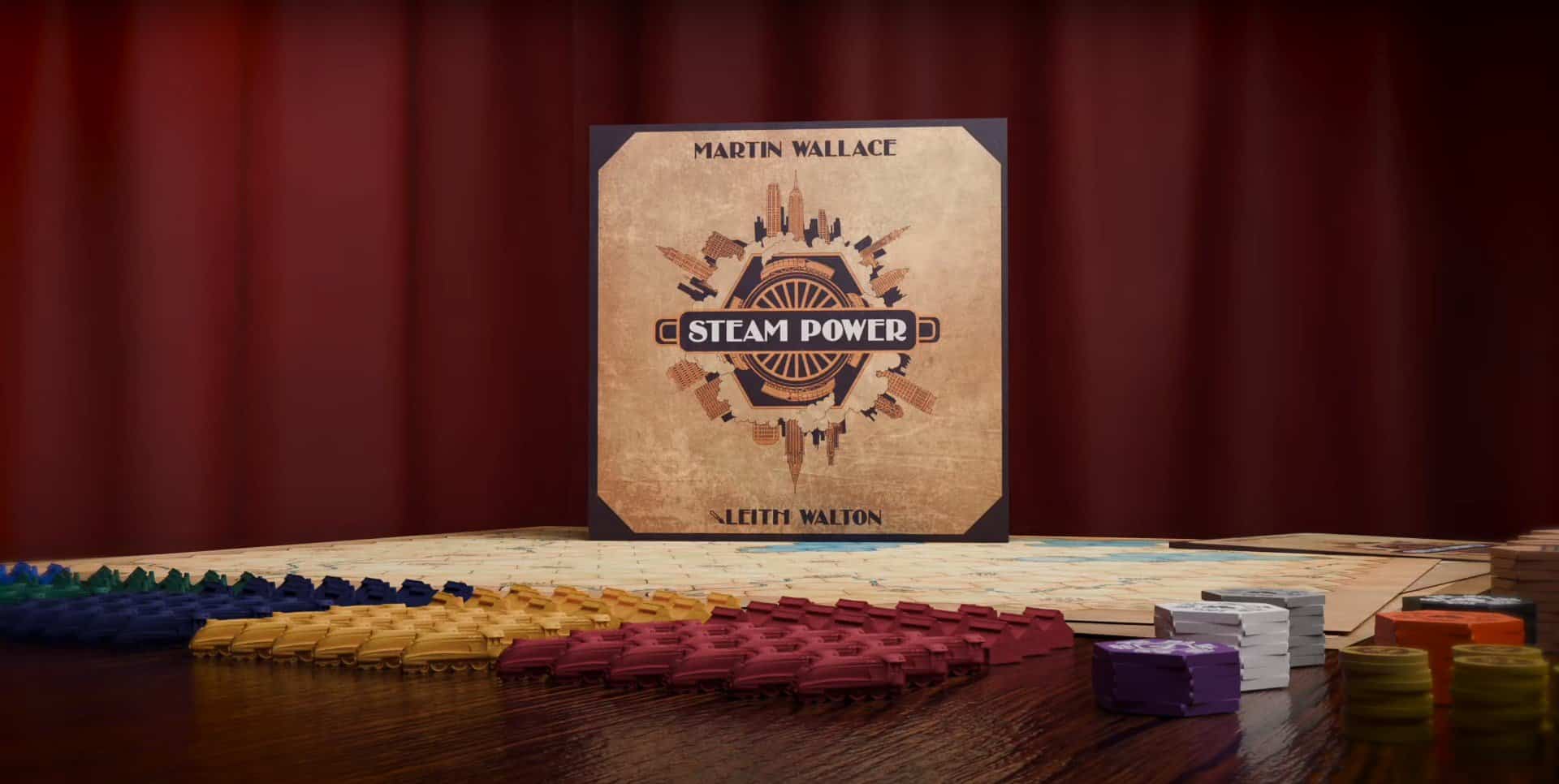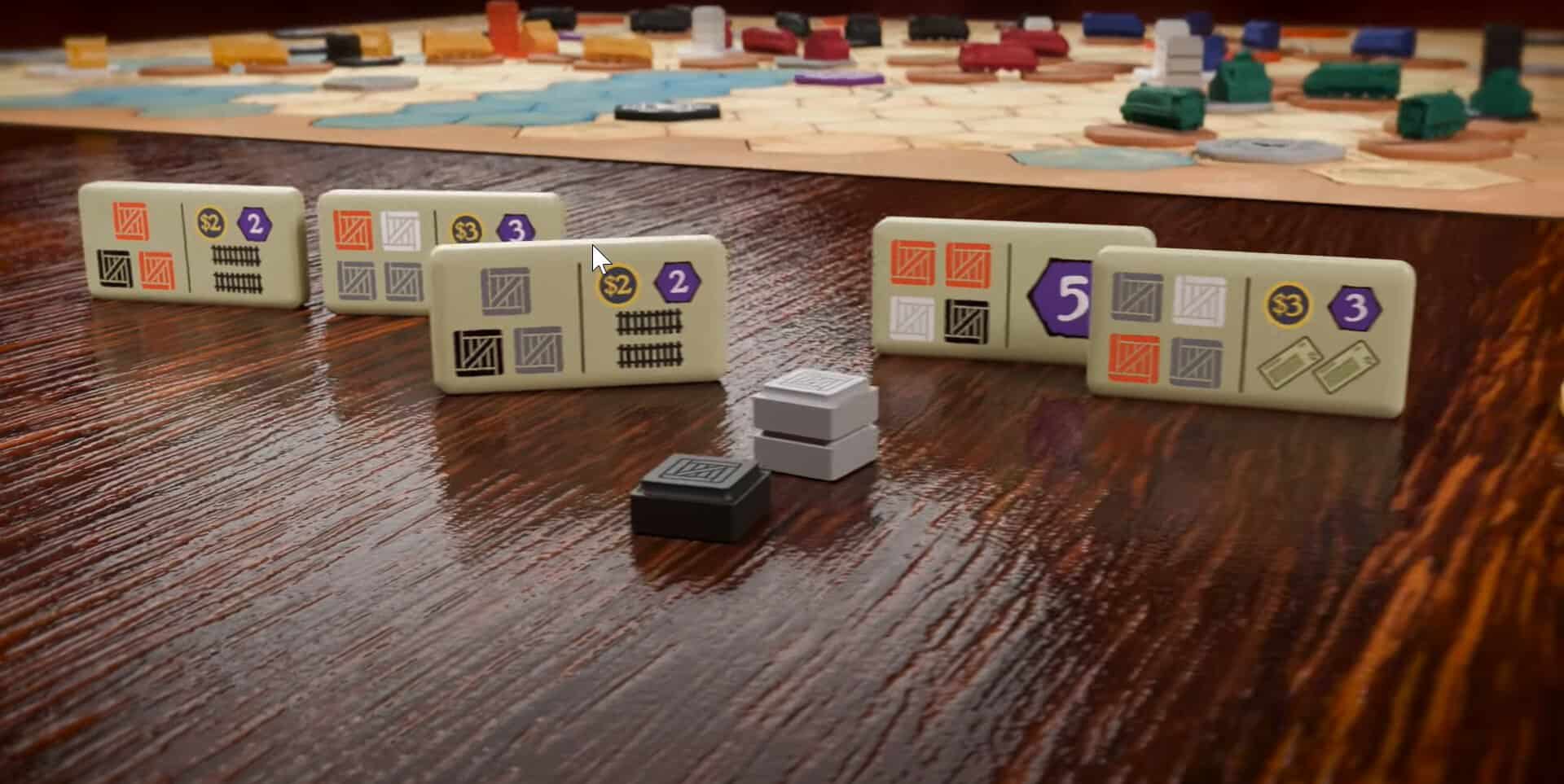Martin Wallace is renowned for his different economic and train games like Age of Steam, Railways of the World, and Brass. His latest title, Steam Power, aims to distil the essence of those games into a quicker, more accessible package. It is currently on Gamefound but does it deliver a satisfying experience or get derailed along the way? I put Steam Power through its paces with my two gaming groups to find out.

Gameplay Overview
In Steam Power, 1-5 players compete to build the most lucrative rail network by laying track, constructing factories, and fulfilling delivery contracts. Each turn, you get to perform two actions chosen from laying track, building a factory, fulfilling a contract, taking money, or drawing more contracts. The goal is to efficiently connect cities and factories to complete contracts for points and cash. The player with the most points when the game end is triggered wins.

The core of the game revolves around an interesting shared incentive. When you build a factory, you place resource cubes on it that are available to all players…for a price. So there’s a balance between jumpstarting resource production that your opponents can access versus focusing solely on your own deliveries. Money is very tight, so you need to time your factory builds and fee collections well.
Compared to Age of Steam, gone are the auctions, shares, and complex track/locomotive upgrades. And unlike Brass, there’s no card-based market demand, technology tree, or canal/rail era distinction. Instead, Steam Power laser-focuses on pick-up-and-deliver, route-building, and contract fulfillment. It’s a much more streamlined affair.

The random contract mix and factory placement leads to a variable setup and forces players to adapt their network to the developing game state. There are some interesting decisions around when to grab a contract, which ones to go for, and how to optimize your track building. The different contract types and special abilities introduce some welcomed asymmetry. But it lacks the tense, knife-fight competitiveness of Wallace’s heavier titles.

Components and Artwork
The production copy I received featured excellent component quality. The game board is mounted on thick cardboard with a lovely period-style map of the Midwestern US. The resource tokens are chunky wooden cubes, the player discs are engraved wood, and the train miniatures are nicely moulded plastic with good heft. The cards are linen-finished with clear iconography.
The artwork really shines. From the sepia-toned cards to the rustic map, the visuals evoke the gritty, rough-and-tumble era of early American rail. Little touches like the cow skull on the money tokens or the old-timey factory illustrations add charm and flavour. Top marks for graphic design and table presence.
Thoughts after Playthroughs
I played Steam Power with two different groups – my regular heavy Euro crew and some more casual family gamers. It was a hit with both, but for different reasons.

My hardcore group appreciated how it condensed the route-building and economic aspects of train games into a quick, 60-90 minute experience. We played on the “Rust Belt” map which had more restrictive terrain and tighter competition for key routes. This led to some fun blocking and jockeying for position, though not quite as brutal as Age of Steam. We enjoyed the shared incentives of the factories, as it rewarded clever timing of builds and collections.
However, we did miss the auctions, stock shenanigans, and deeper economic complexities of the 18xx games and Brass. The decisions, while meaningful, felt a bit more rote and constrained. For a meatier train gaming experience, we’d probably still reach for Steam’s heavier siblings.

My casual group had a blast with the game. One player, a big Ticket to Ride fan, loved how it offered a step up in strategy without overwhelming her. The contract fulfilment goals and limited actions made it easy to parse her options. Another friend enjoyed the puzzle-y efficiency aspect of organizing his network and maximizing his point-to-money ratio. The shared incentives and contract combos led to some surprises and kept things engaging.
For this group, the experience was a clear winner. It had enough meat to keep them thinking and invested, but played breezy enough to get in two games in an evening. The ruleset was easy to grasp and the random setups kept it fresh. I can see Steam Power hitting the table regularly with them as a medium-weight opener or closer.
One memorable moment came when my brother-in-law, usually a reluctant gamer, pulled off a clever contract play by perfectly timing a factory build to block me from completing a delivery while setting himself up for a huge point swing. His “a-ha!” grin and fist pump as he raked in the points was priceless. Steam Power seems to deliver those satisfying moments of mini-triumphs quite well.

The game does have some limitations. The randomness of the contracts and factory locations can occasionally result in lopsided setups or runaway leader situations, especially with lower player counts. And as mentioned, the constrained decision space and lack of auctions/stock won’t satisfy gamers seeking heavier fare. But for its target audience and playtime, it succeeds admirably.
Final Verdict
While it may not have the gravitas or grit of its bigger train game siblings, Steam Power is a lovely addition to the Wallace canon. By stripping down the pick-up-and-deliver, route-building, and contract fulfillment elements to their essence, it offers a breezy yet brain-tickling experience that works equally well for family gatherings or game groups seeking a medium-weight economic filler.
The production quality is top-notch, the artwork charming, and the shared incentive mechanics cleverly implemented. It’s a game I’ll happily introduce to new groups as a step-up from gateway titles or a less bruising alternative to 18xx/Brass. With the variable setups and different maps, I expect it to hit the table quite regularly, especially with my more casual crowd.
If you’re seeking a knife-fight on the rails or an unforgiving logistics puzzle, stick to Age of Steam or Brass. But if you want a quick-playing, easy to parse yet engaging train game with some neat twists, Steam Power is well worth a ride. Choo-choo-choose it for your next game night.
